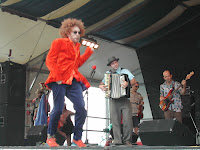A Letter to My Friend Henry

Dear Henry:
It was great talking to you today, and congratulations on your new job teaching at the local university-- all the better that you didn’t have to go to grad school to land the gig. I have so much respect for you and all the people, including our good friend Kelly McClure, who have stayed or come back to New Orleans to make it a better place.
Yet, I was struck by the divide between your sense of the recovery as someone living it on a daily basis and mine, a former resident, who recently visited for another post-flood look around. Your cheerful rendition of progress and hope, including the ten-year perspective when everything will be better, the levees repaired and the city improved, didn’t jive with my experience, reading or gut instinct. I hope and pray you’re right, but fear that neither hope nor prayer is enough in this situation.
Since Katrina, dialogue can be easily strained between those who are there like you, doing the Lord’s work, and the rest of us like me watching on safely from the sidelines. But then talking about New Orleans is never simple. It’s a place whose insiders cling passionately to her charms and take a historically laissez faire attitude to her many challenges. As you said today, it’s not for everybody, certainly not in the city’s present condition. Sadly, it’s not for me.
I am afraid for New Orleans, but probably more to the point I am afraid of New Orleans despite a deep love for the place. That was true before Katrina, and I left in 1998, slightly heartbroken and feeling a little like Lot leaving Sodom. Death and decay linger over every aspect of the joy-filled life there. My fear is only amplified by crime, a seeming lack of progress in rebuilding and what looks from the outside like an unwillingness to demand more from local leaders and the outside world. New Orleans deserves more than what it can muster on its own – better levees than the ones the Corps is currently building, safer streets, a true and sincere approach to Wetlands renewal and a more progressive and tax/regulation friendly environment for would-be entrepreneurs and adventurous business people looking to stake their claim and help grow the city into something new and vibrant.
New Orleans’ unique culture including its music, food and street traditions is near and dear to my heart, as I know it is to yours. I was glad to hear you talk about its revival, hopefully ensuring the heritage of the city’s arts from high to low. But powerful hurricanes care nothing for the things man creates, and longstanding local bravado aside it’s really only a matter of time before the real Big One hits home. The levees that are being rebuilt today will offer little protection when that happens. As LSU’s Ivor van Heerden says: “Katrina wasn’t even close to being the big one.”
I realized today, after we talked and as I was sitting in the suburban shopping Mecca of Austin’s Arboretum having ice cream with my kids, that I wasn’t willing to pay the price necessary to come back to the New Orleans that remains today, making my sense of loss all the more poignant. Frankly, it’s the New Orleans that was, if only in my memory banks, that I miss, not the place that it is today. That’s OK. New Orleans will move on with or without me, and my talents are better suited to that of memoirist than post-storm polemicist.
Some people will fight to the death to stay in New Orleans even as catastrophe looms, making their way through the wreckage to have yet another party. To expect otherwise, is to miss the point. Maybe I’m just relieved that my curfew forced me to leave the fete before things got really wild!
I look forward to seeing you the next time I come through town. Hopefully we can have dinner at Galatoires, again.
Yours truly,
Steve

